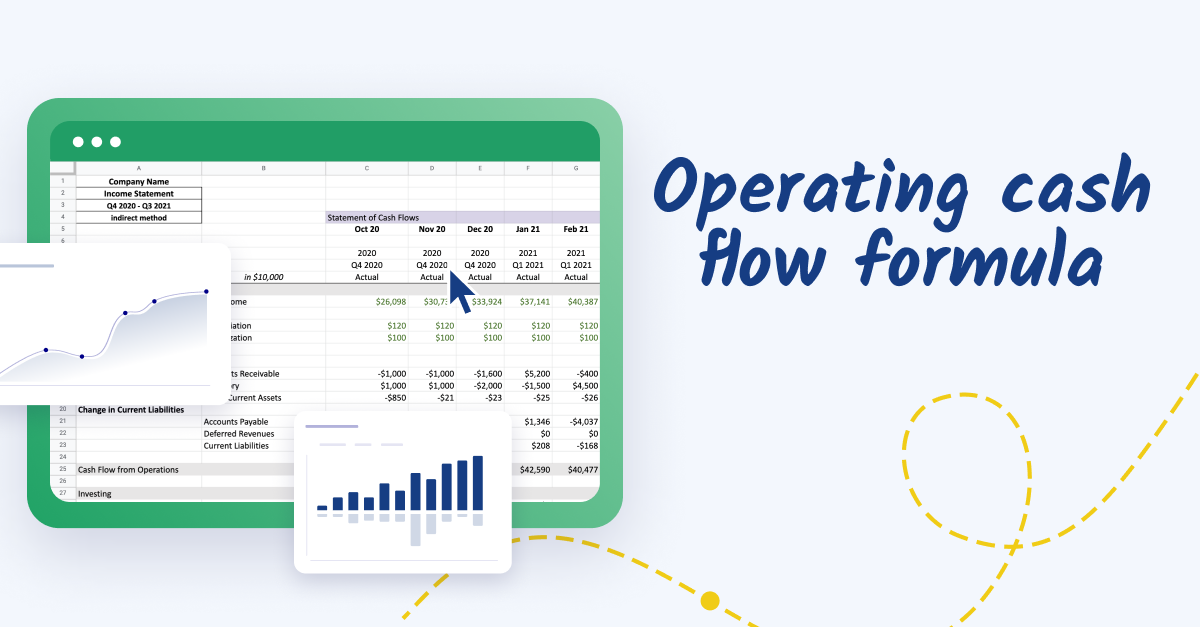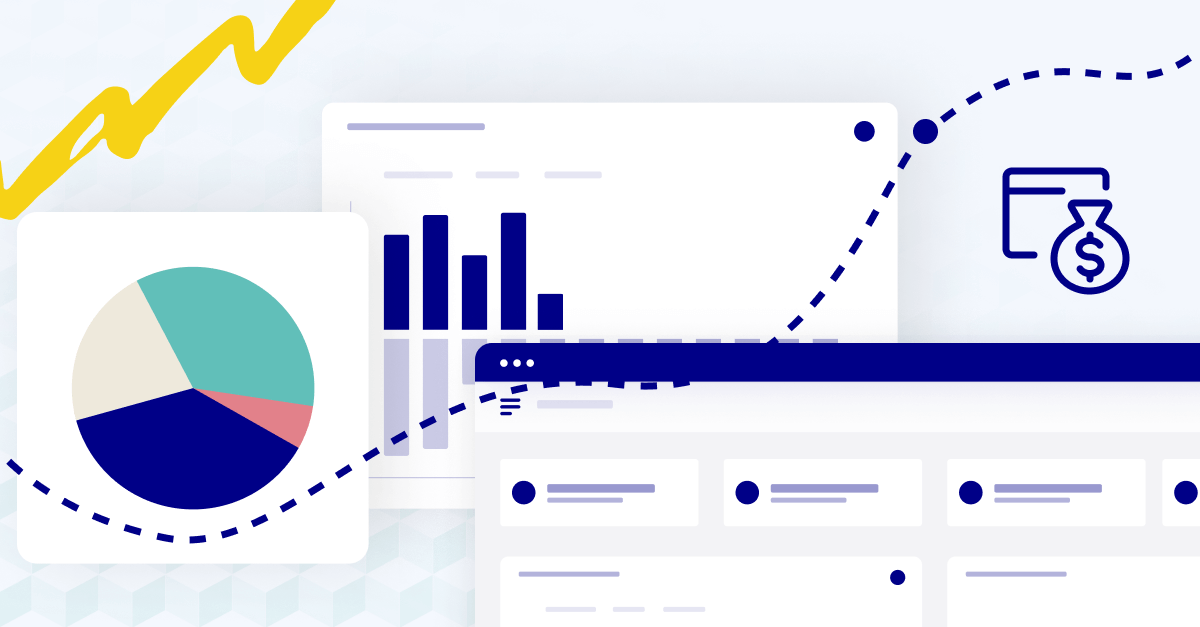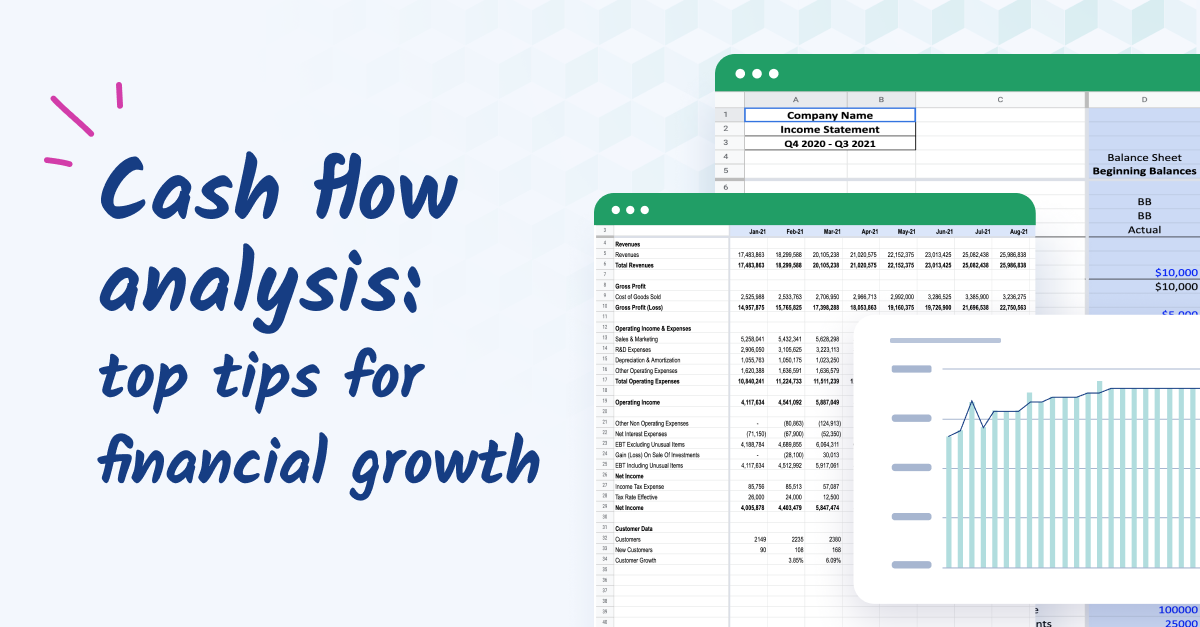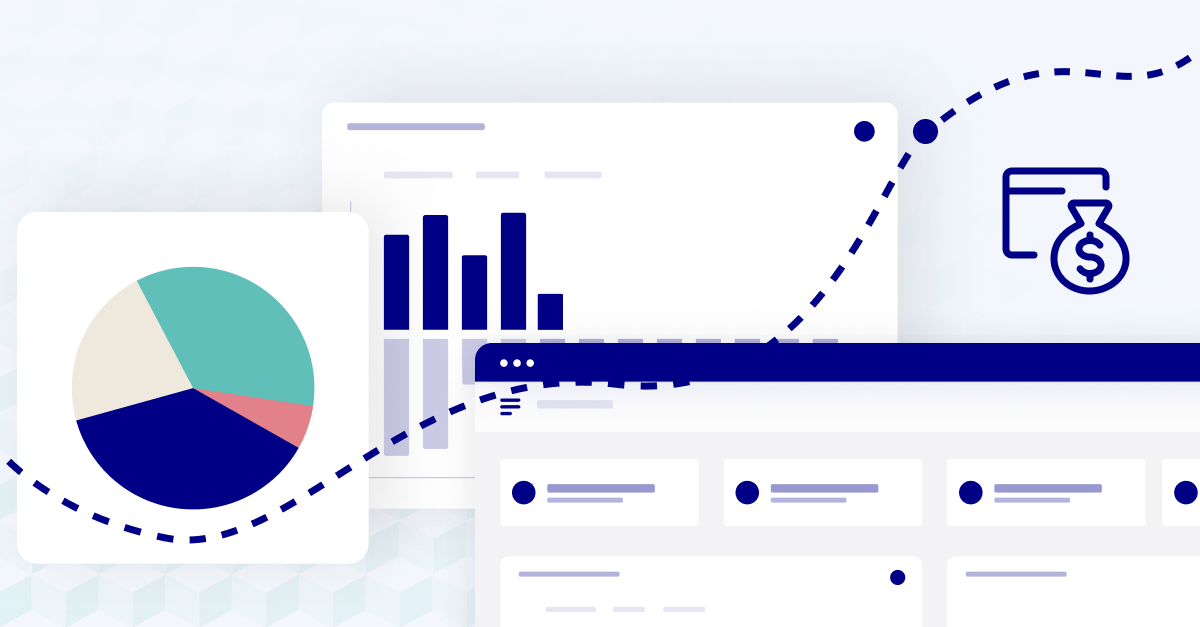Understanding operating cash flow
Operating cash flow is the cash that comes in (and goes out of) company accounts from their main business activities.
So for a chain of pet shops, for example, operating cash flow would include all the money paid from selling dog food, bird cages, fish tanks, and everything else in-store, as well as expenses such as wholesale costs for the goods and staff wages.
It's important to note that operating cash flow doesn’t include figures outside of the company’s core business (e.g., interest costs on company debt, gains made on investments, or interest generated on cash holdings).
It’s for this reason that operating cash flow is a useful indicator of a company's efficiency and the overall financial health of its business model.

Assessing your current operating cash flow
If you want to start digging into your company’s cash flow, you need to start with the cash flow statement. The statement of cash flows is split into three parts, but the one we want to focus on is the Operating Activities section. This section focuses on cash flow related to core business operations.
The operating cash flow formula
Before you start digging into the numbers, you need to understand the operating cash flow formula. There are two options for this: the direct and indirect method. You can find out more about the direct vs. indirect methods here.
For the purposes of this blog, we’re going to focus on the indirect formula, which is:
Operating Cash Flow = Net Income + Depreciation & Amortization - Net Working Capital
The operating cash flow formula provides a true picture of the cash coming in and going out of a business, taking out the impacts of account techniques aimed at reducing tax and accounting for outstanding accounts payable and receivable.
Depreciation and amortization is added back to net income, as it’s an accounting deduction which doesn’t reflect a real reduction in cash. The change to net working capital solves the issue of accounts payable or accounts receivable that have been raised but not yet paid or received.
Analyzing operating cash flow
Once you’ve used the operating cash flow formula to calculate operating cash flow for the company, you may notice some details within the data that give you some insight into the financial health of your company.
For example, net income figures may be down substantially from the previous period which could be a cause for concern. However, if there has been a much higher level of depreciation due to new asset purchases, these numbers will be added back in the operating cash flow formula, giving a clearer picture of your company’s performance.
It can also be useful to build comparisons. These can be made to previous years, to assess the overall trends of the financial efficiency and management of cash against past periods. At the same time, comparisons can be made against industry leaders or industry averages to give more context.
Operating cash flow red flags
- Negative operating cash flow: This suggests that there are some fundamental issues with the business model. These may be due to fluctuations in demand or a spike in costs, but the issue should be looked at closely to determine the cause and whether it is a short-term issue or a potential systemic problem.
- Large changes in working capital: Healthy revenue and profit figures accompanied by a significant drop in working capital can be a sign of business risk. It could be that some or all customers are having trouble paying their bills, or that there are some internal issues with management of inventory.
- Reliance on non-operating cash flow: A reliance on investing or non-core activities to generate profits is something that needs to be looked at carefully, and should factor into FP&A teams balance sheet projections.
Strategies for increasing cash inflows
Luckily for finance and FP&A teams, there are many ways to improve financial efficiency and grow cash inflows. The following is a small sample of cash flow best practices and strategies which can help, giving you a starting point to improve the management of cash and boost inflows.
Increase sales
Yes, this seems obvious, but one of the best ways to improve operating cash flow is to increase revenue through higher sales numbers. While the overall strategy might be simple, there are almost unlimited ways to achieve it.
It could be as simple as increasing the size of your sales force or raising their targets. You could lower your prices, offer special promotions, launch a new marketing campaign, or expand into a new geographic area. For expansion or plans that require a large investment, it’s important to implement the right capital budgeting techniques to ensure that potential future profits outweigh the upfront costs.
Increase average sale size
Growing the number of sales is one thing, but another method of increasing cash is to up your average sale size from your existing customer base. This can involve looking for cross-selling opportunities or adding features to your products or services that come with additional charges.
This strategy could also include a review of your pricing so you are maximizing profits where demand is the highest. Strategic partnerships with a profit share arrangement are worth considering, as well as looking at ways to generate additional revenue from underutilized assets like customer data.
Improve the invoicing and collections process
A major source of drag on cash flow is the time it takes between work being invoiced and a company being paid. This process can almost always be improved with better systems, and these days there are a wide variety of software solutions that can help.
Simple additions such as automated payment reminders and offering multiple ways to pay can bring down receivables, and so can a review of your payment terms.
Effective management of cash outflows
Minimizing outflows is equally as important in improving cash flow as maximizing inflows. Here are some additional strategies to help balance the costs size of the operating cash flow formula.
Reduce costs of goods sold (COGS)
One of the most obvious ways to reduce outflows is to lower the cost of goods sold. Renegotiating contracts with suppliers can yield additional percentage points of gross profit, which flows directly through to operating cash flow.
Improve inventory management
Holding excess stock can become very expensive and can have a major impact on operating cash flow, making inventory management an important capital budgeting technique. The use of technology and software can pay big dividends here, with cash forecasting able to better predict inventory needs throughout the year.
Better inventory management means improved financial efficiency, without the need for any reduction in product or service quality, making it an area that FP&A teams should put significant focus into.
Long-term thinking
Along the same line, broader long-term strategic planning can improve the systemic efficiency of a business and help reduce unnecessary outflows in the future. Creating long-term forecasts and corporate plans gives executives more time to execute them, which can lead to better prices and less reliance on volatile “on the spot” purchases.
For example, consider a growing company looking to build an additional manufacturing facility. They’ll have more time to find and negotiate cost effective contracts if they are planning multiple years ahead than if they are scrambling to keep up with demand.
Cash flow forecasting and planning
Long-term planning is key to growing and sustaining healthy operating cash flow. Accurate and timely projected cash flow and balance sheet projections will ensure that executives are able to make considered strategic decisions, rather than being rushed into options that might not be optimal. Not only does this provide better opportunities for growth, but it helps reduce business risk.
There are a number of important factors to consider when creating effective cash flow forecasts, such as:
- Data accuracy: To ensure cash flow forecasts are as valuable as possible, FP&A teams need to ensure their data is accurate. You need to be able to trust that the information you’re looking at is correct so future decisions are based on facts.
- Accessibility: There’s no point having the world’s most accurate data if it takes you months to find it all. By the time you’ve created a forecast, the landscape will have changed and it will be out of data. For effective cash flow forecasts, FP&A teams need to be able to find the right financial data quickly and easily.
- Buy-in from stakeholders: Every department needs to feel that their projections are realistic and achievable, from sales and marketing to HR and engineering.
- Flexibility: Forecasts are important, but they are never going to be 100% accurate. The best projections have room to flex in the changing market environment.
Leveraging technology for cash flow optimization
Technology has drastically improved cash flow optimization, and there are a wide range of tools available to help automate and simplify the process for companies of all sizes.
These tools connect up different parts of a company’s web of financial data, helping consolidate and automate reporting and analysis. This can save significant time, allowing your team to operate leaner and more efficiently, which can improve operating cash flow.
Cube is one such example. An FP&A platform designed for modern businesses, it offers dynamic financial planning solutions for crafting cash flows, building multiple scenario forecasts and analyses, and more. Cube delivers a comprehensive solution, streamlining all your cash management processes in one place.
Best practices and actionable insights
Like many aspects of business, maintaining healthy operating cash flow is simple in theory—but it's far more complicated in practice. Here are some final cash flow best practices and insights for maintaining healthy operating cash flow:
- Conduct robust forecasts: As the saying goes, failing to plan is planning to fail. The right forecasts can help your executives make decisions to maximize operating cash flow.
- Efficient invoicing and receivables: Quite simply, make sure you’re getting paid, on time, for the work you're doing.
- Manage expenses: Where possible, keep costs down. This shouldn’t come at the price of the quality of your product or service, but always be looking for ways to cut expenses.
- Utilize technology: Implement software to streamline processes, and leverage automation to reduce errors and save time.
- Diversify revenue: Reducing reliance on a small number of customers or business segments can help maintain healthy operating cash flow, even if certain customers fall behind on their payments or cut their average purchase size.
- Manage inventory: Going hand-in-hand with robust forecasting, avoid tying up working capital in stock with accurate projections on inventory requirements.
Conclusion: keeping an eye on cash flow
Operating cash flow is a useful indicator of a company's efficiency and overall financial health. By effectively managing cash, monitoring transactions, and using forecasting tools, you can improve your company's financial stability and support growth.
Want to learn how Cube can help make this process simpler and more efficient? Request a free demo today.



.png)









